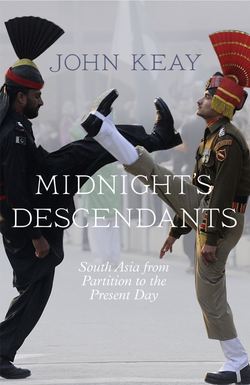Midnight’s Descendants: South Asia from Partition to the Present Day

Реклама. ООО «ЛитРес», ИНН: 7719571260.
Оглавление
John Keay. Midnight’s Descendants: South Asia from Partition to the Present Day
Copyright
Illustrations
Maps and Charts
Author’s Note
Introduction
1. Casting the Die
2. Counting the Cost
3. Who Has Not Heard of the Vale of Cashmere?
4. Past Conditional
5. Reality Check
6. Power to the People
7. An Ill-Starred Conjunction
8. Two-Way Tickets, Double Standards
9. Things Fall Apart
10. Outside the Gates
11. India Astir
Epilogue
Postscript
Picture Section
Notes. Introduction
Chapter 1 – Casting the Die
Chapter 2 – Counting the Cost
Chapter 3 – Who Has Not Heard of the Vale of Cashmere?
Chapter 4 – Past Conditional
Chapter 5 – Reality Check
Chapter 6 – Power to the People
Chapter 7 – An Ill-Starred Conjunction
Chapter 8 –Two-Way Tickets, Double Standards
Chapter 9 – Things Fall Apart
Chapter 10 – Outside the Gates
Chapter 11 – India Astir
Epilogue
Bibliography
Index
By the same author
About the Publisher
Отрывок из книги
In Memory of Julia Keay
Title Page
.....
In 1947 the majority of refugees headed for the nearest of the new borders. If they made it to the other side – a big ‘if’ in the Punjab – they settled down among their co-religionists in India or Pakistan. Some were allocated land that had been vacated by refugees moving in the opposite direction; others swelled the populations of the cities and thereby transformed the parent state’s demography. Karachi, the interim capital of Pakistan, attracted so many displaced Muslims from India that these muhajirs soon outnumbered the city’s native Sindhis. Delhi, if judged by its taxi-drivers, became a city of Sikhs, mostly refugees from Lahore; Lahore became a city of Muslims with scarcely a beturbanned Sikh to be seen; and Calcutta lost its public spaces when parks, gardens, railway stations and even cricket pitches were turned into makeshift dormitories by the displaced from all over eastern Bengal.
A few migrants quickly changed their minds and went back, some doing so several times. Others had their minds changed for them. When in 1971 East Pakistan became Bangladesh, refugees from India who had been welcomed into East Pakistan as Muslims in 1947 found themselves interned as non-Bengalis in a now proudly Bengali Bangladesh. Perhaps 100,000 of these so-called ‘Biharis’ are still there, eking out a pitiful existence in Bangladesh’s refugee camps; others have been shunted across India to Pakistan; and a lucky few have since obtained visas to reside overseas.
.....